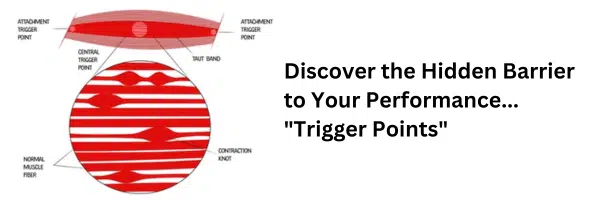Introduction:
Trigger points are areas of hyperirritability within a muscle that can cause localized pain as well as referred pain. They have been described as small, painful nodules that can be found within muscles and can cause discomfort, pain, and reduced range of motion. Trigger points may be caused by a variety of factors, including overuse, stress, and injury. In this article, we will explore the effects of trigger points on muscle function, blood flow, oxygen flow, and acetylcholine, highlighting relevant research studies
Effects of Trigger Points on Muscle Function:
Trigger points can have a significant impact on muscle function. They can cause muscle weakness, stiffness, and reduced range of motion. In a study of patients with chronic myofascial pain, trigger points were found to decrease muscle strength and endurance compared to muscle tissue without trigger points (Simons et al.,2002). Furthermore, trigger points can contribute to a decrease in muscle coordination and balance, making movement and daily activities more challenging
Effects of Trigger Points on Blood and Oxygen Flow:
Trigger points can also affect blood and oxygen flow to the affected muscle. In a healthy muscle, the flow of blood and oxygen is essential for proper muscle function and recovery. However, in muscles with trigger points, blood flow and oxygen delivery can be compromised. This can result in a decrease in the endurance and strength of the muscle, leading to reduced muscle function and pain. A study by Shah et al. (2008) found that the presence of trigger points can lead to decreased blood flow and oxygen saturation within the muscle, contributing to the development and persistence of trigger points.
Effects of Trigger Points on Acetylcholine:
Acetylcholine is a neurotransmitter that plays a critical role in muscle contractions and proper muscle function. In muscles with trigger points, acetylcholine can be affected, contributing to the development and persistence of trigger points. A study by Hong et al. (2008) found that muscles with trigger points had a decrease in acetylcholine receptor density. This decrease can result in a reduction in the release of acetylcholine at the neuromuscular junction, leading to decreased muscle contractions and muscle weakness.
Conclusion:
In conclusion, trigger points can have a significant impact on muscle function, blood flow, oxygen flow, and acetylcholine. They can cause muscle weakness, stiffness, and reduced range of motion, as well as decreased endurance and strength. Trigger points can also compromise blood flow and oxygen delivery to the affected muscle. Furthermore, they can affect acetylcholine release and receptor density, leading to decreased muscle contractions and muscle weakness. Proper diagnosis and treatment of trigger points are essential to prevent these adverse effects on muscle function and improve the quality of life of individuals suffering from chronic and acute musculoskeletal pain.
Treatment Options for Trigger Points:
There are several treatment options for trigger points, including:
- Manual Therapy/Massage Therapy: This involves the use of hands to apply held sustained pressure (trigger point release), stroking or stretching the affected area. This helps to release the tension in the muscles and relieve the pain caused by trigger points.
- Stretching exercises: Stretching exercises can, at times, help to ease the tension in the muscles and reduce the frequency of trigger point occurrences. The research and effectiveness is questionable here however, but in some cases, it works.
- Dry needling: This involves inserting a thin needle into the trigger point to help release the tension and promote oxygen and blodd flow, as well as show positive effects on acetylcholine action. Research now heavily supports this modality.
- Heat or cold therapy: The application of heat or cold to the affected area can help to reduce pain and promote healing. It hasn’t shown to be heavily affective on trigger points however, but can relieve symptoms
- Medications: In some cases, over-the-counter pain medications or muscle relaxants may be recommended to alleviate pain.
- Exercise Rehabilitation: As Trigger Points often result from overuse and/or repeated postures, it’s important to gain the very best movement patterns. So I always suggest exercise rehabilitation as an important additive post treatment of Trigger Points.
It’s important to note that treatment options may vary depending on the severity of the trigger point and the individual’s medical history and preference. It’s important to talk to a healthcare provider before starting any new treatment.
References:
Hong CZ, Chen YC, Pon CH, et al. (2008). Quantitative ultrasound elastography imaging of soft tissue damage due to myofascial trigger points: assessment of reliability. J Bodyw Mov Ther.12(3):298-304.
Shah JP, Danoff JV, Desai MJ, et al. (2008). Biochemicals associated with pain and inflammation are elevated in sites near to and remote from active myofascial trigger points. Arch Phys Med Rehabil.89(1):16-23.
Simons DG, Stolov WC, Mastellos VP. (2002). Myofascial pain syndromes due to trigger points. In: Wall PD, Melzack R, eds. Textbook of Pain.4th ed. Edinburgh: Churchill Livingstone;1023-1051.

